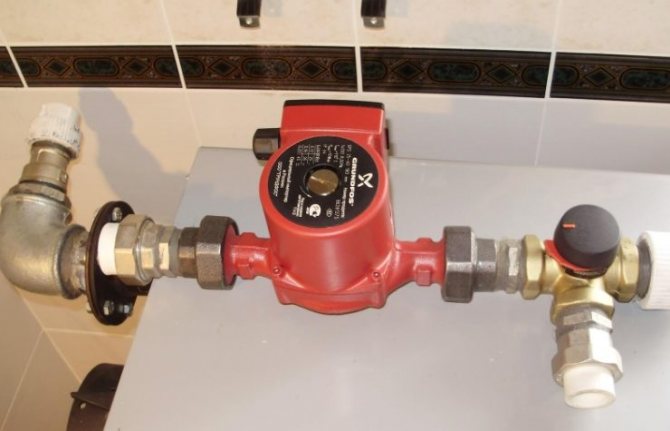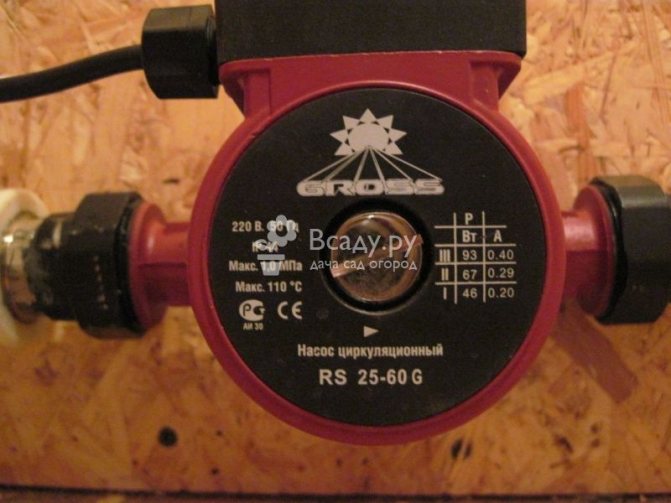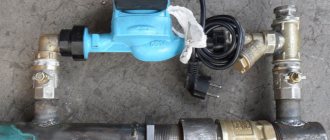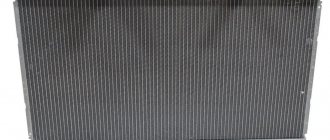What is the difference between forced circulation and natural circulation?
With natural circulation, the coolant in the pipes moves by itself, under the influence of gravity. Forced implies the presence of a pump that pushes the coolant in the pipeline, accelerates its movement. There are advantages and disadvantages to such a system.
Pros:
- the inertia decreases, the speed of movement increases. A pump for heating in a private house allows you to fill the circuits with hot coolant in a short time. This also applies to long paths too. With natural circulation, water often flows to distant radiators already cooled, and does not rise to the second floor at all;
- uniform heating;
- since the water flows under pressure, the number of air locks decreases;
- in gravitational systems, pipes with a large cross section are used - the lack of speed is compensated for by a large volume of water;
- for natural circulation to work, the pipeline must be installed at a certain angle. If there is a pump for the heating system, the pipes can sometimes even have a negative slope, the pump will cope with this obstacle. Installation of such a pipeline is much easier.
Disadvantages:
- additional equipment costs - the cost of the pump itself;
- the cost of electricity from which the pump runs;
- volatility. In the event of a power outage, the system will stop working, the house will cool down.
The last problem is the most serious when installing a circulation pump for heating: how to install it correctly depends on the characteristics of the system. If you put it in parallel on a bypass, in the absence of electricity, the coolant will be able to circulate naturally.
But at the same time, the aforementioned difficulties will arise: low speed, uneven heating. It is better to go for additional costs: purchase an autonomous energy source for the house (what is a generator for a heating boiler).
Installing a circulation pump in the heating system
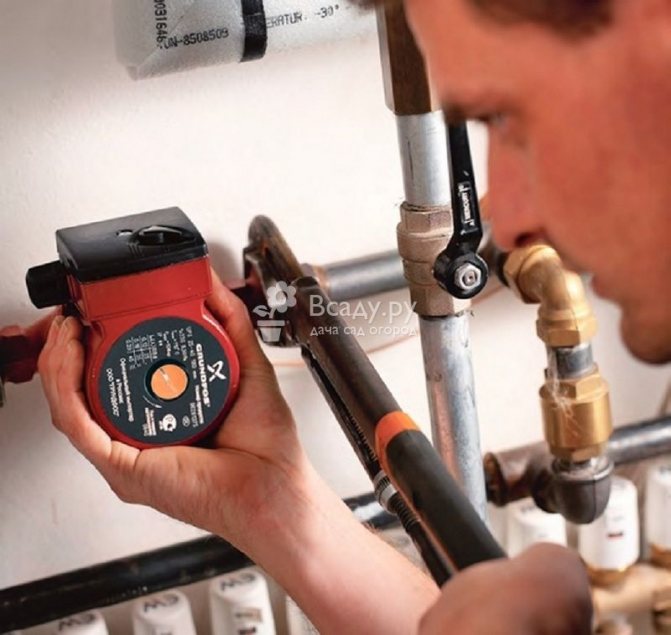
Installation of a pump in the heating system of a private house
So, the circulation unit has been selected, but now you need to mount it correctly. The installation of the pump presupposes careful selection of the installation site for the unit. It must meet several parameters:
- first, have enough free space for easy access;
- secondly, the pump diagram must be followed during installation.
Wet pumps of the previous generation, for the sake of safety and prolongation of the service life of the devices, were mounted only in the water return system (colder water destroys the mechanisms to a lesser extent). But in modern models, rotors are made of corrosion-resistant materials for which hot water is not an obstacle (for example, ceramics), so the latest models of "wet" circular pumps can be installed in the supply system.
Installation of pumps should be carried out in the place where shut-off valves (ball valves) are installed before and after the pump. This will allow in the event of an emergency to quickly disconnect the unit from the coolant supply. Before water enters the pump, it is necessary to provide for the installation of a cleaning valve in the pipeline, the main task of which is to prevent the ingress of mechanical particles into the pump cavity.
The pumps can be installed in both one-pipe and two-pipe heating systems. The first case is characterized by a uniform flow rate of the coolant with insignificant temperature differences.And the second, on the contrary, is distinguished by significant temperature differences and this must be taken into account when choosing a model.
Wet circulation units are installed in the heating system only in a horizontal position - this way you can achieve a long service life of the device, reducing the wear of the internal mechanisms. The pump must be installed in the heating system using a special sealant or thread seals to help avoid leaks.
The circulating pump is an electrical device, therefore, it should be connected only to an earthed circuit that is equipped with a protection system (bags, fuses).
Pump connection sequence:
- Clean and drain the heating piping system, check all drains and sedimentation tanks for the presence of water;
- The installation of the circulation pump in the heating system must be carried out in strict accordance with the manufacturer's instructions;
- When installing, use a sealant or thread sealant (fum tape);
- After completing the installation, carefully fill the system with water to check the performance of the equipment by monitoring the pressure on the pressure gauge (most often installed on modern boilers);
- Run water through the pumping equipment by opening the screw on the top of the housing. The appearance of water on the upper surface of the hole indicates the complete elimination of air bubbles.
- Proceed to start the electrical part of the pump while still monitoring the pressure.
There are also automatic ways to exclude air (automatic air vents installed at the highest points of the floor heating distribution lines), they will help save time when starting the unit, but their use will require additional capital investments for the purchase of these devices.
Circulation pumps for heating systems connection diagrams


Circulation pump connection diagram


Heating system project for a two-story private house
Device and types
The pump consists of a rotor, shaft, impeller, electric motor and housing. The principle of operation is centrifugal. An impeller (impeller) is two discs connected by curved blades. The discs have holes for the intake of the coolant and for attaching the wheel to the shaft.
When rotating, the impeller draws water into the pump and, due to centrifugal force, pushes it further into the circuit under pressure. A vacuum is formed in the intake zone, and increased pressure in the outlet zone. The rotation of the shaft with the impeller is carried out when energy is supplied from the motor.


Pumps are divided into two large groups: dry and wet. To install a circulation pump in the heating system of private houses, wet ones are usually used: in this design, the coolant washes the engine and performs the function of lubrication.
In dry cases, the engine does not come into contact with water, it easily overheats, which affects its durability.
The power of dry pumps is high; as a rule, there is no need for it in a private house.
Choosing a pump for heating a house
Before proceeding with the installation of a pump for heating, it is necessary to select it correctly. As a rule, for heating a private house, so-called "wet" circulation pumps are used, a rotor (with an impeller), which is located directly in the coolant. The latter, in this case, plays the role of both cooling and lubrication. Such water pumps, although they have a relatively low efficiency (up to 50%), are easy to install, operate and repair, and also have low noise.
Choose a pump for heating according to its main characteristics: pressure (in m.w.c. Or bar) and flow (capacity - in m3 / h). Most often they are presented in the passport or instructions in the form of a graph. Therefore, when choosing a pump, you need to know what kind of flow it should provide at a certain head.
The required flow depends on the power of the heating boiler and the amount of heating medium in the system required for optimal heat transfer from the radiators. In addition, it is necessary to take into account hydraulic losses, which depend on the material, diameter and length of pipes, the wiring diagram, the number and type of shut-off and control valves, as well as the type and volume of radiators.
When installing a closed system, the pump must provide a pressure (head) in it - not less than 1.5 bar (about 15 m of water column). In open systems, the pressure is determined by the installation height of the expansion vessel. Read more about choosing a pump in the article: "Circulation pumps for heating".
Installation features
How to install a heating pump in a heating system? To minimize obstacles in the path of the coolant, to ensure complete cooling of the working parts, the working shaft must be located strictly horizontally.
In most cases, the connection diagram of the circulation pump to the heating system looks like this: the device is placed on the return pipe in front of the boiler entrance. A mud filter is installed in front of the pump. Its task is to retain sand, scale particles, scale and other abrasive elements that can damage the impeller or bearings, and reduce the service life of the device.
Why installation of a circulation pump in the heating system is preferable for the return flow: bearings and plastic elements of the device are sensitive to high temperatures. Hot water reduces their resource.


If the house is heated with underfloor heating, installing the pump into the heating system with your own hands can also be done on the supply, since the coolant in the underfloor heating is low-temperature, within 50 degrees. If the heating is radiator - only for the return.
Air-to-water heat pump connection diagram


The peculiarities of the air-water heat pump connection diagram include only the possibility of an unlimited length of lines connecting the external block of the heat pump with the heating system. Such a heat pump can be located in a convenient place on the site, roof or facade of the house.
This applies only to monoblocks air-water, which can be installed at any distance from the boiler room with appropriate insulation of water lines. For split heat pumps, the indoor unit is installed in the boiler room and connected to the supply and return of the heating system, like a conventional boiler.
System expansion
If the area of the house has increased, the old equipment is no longer enough for full heating, a second boiler and an additional pump in the heating system are needed. The place of its installation will depend on the general scheme with two boilers.
In some cases, the installation of an additional pump in the heating system is also recommended with one boiler: if it is powerful, the house is large, there are many circuits, the scheme is combined (underfloor heating + batteries). In the latter version, it is desirable to also have two collectors (for radiators and for the floor), each with its own pump.
Heat pump connection diagrams
The connection diagrams of heat pumps to the heating system do not depend on the type of heat pump. Differences can only be in the arrangement of the external collector for the water heat pump or the installation location of the outdoor unit of the air heat pump.
In general, a typical heat pump connection diagram looks the same as for an electric boiler.


Thus, you can take any typical heating scheme that suits your heating system and use it to connect the heat pump.
Installation
How to connect a pump to a heating boiler when the scheme and location are selected?


The procedure is as follows:
- Drain the coolant, clean the pipeline.
- Cut the bypass into the pipe, put the pump on it.
- Insert ball valves on both sides of the device - in case of shutdown / repair / dismantling of the pump.
- On the section of the line next to the bypass, a shut-off valve is also needed.
- Install a cleaning filter in front of the pump itself.
Video about installing a circulation pump in a heating system.
Fixation scheme
Circulation pumps are made of materials that can withstand temperatures up to 120 degrees. Thus, you can safely install them both in the direct feed circuit from the boiler and in processing, there are no restrictions in this. The most important thing is that the block works in the correct direction and does not interfere with the movement of the general flow. If you know how to properly install the circulation pump, then you can significantly improve the heat transfer.


The installation of the circulation pump does not require much effort, but if in doubt, it is better to seek the help of a qualified specialist.
Fundamental nuances:
- The best option is to connect the pump at the outlet from the boiler to the first branch. In this case, the system will immediately actively increase the speed of the hot agent.
- If the house is heated by two branches or there are separate circuits used for technical needs, then it is better to install several devices in different directions.
- There are parts that do not tolerate temperatures above 100 degrees, in which case the equipment is installed for processing, when approaching the boiler. Thus, the circulating unit will suck out the cooled agent.
- By installing several circulation pumps in a large house, energy costs can be significantly reduced.
To connect everything correctly, of course, it is better to invite a competent specialist who will do everything at the highest level. Professional installation of a pump for heating means additional guarantees, free maintenance and many advantages.

